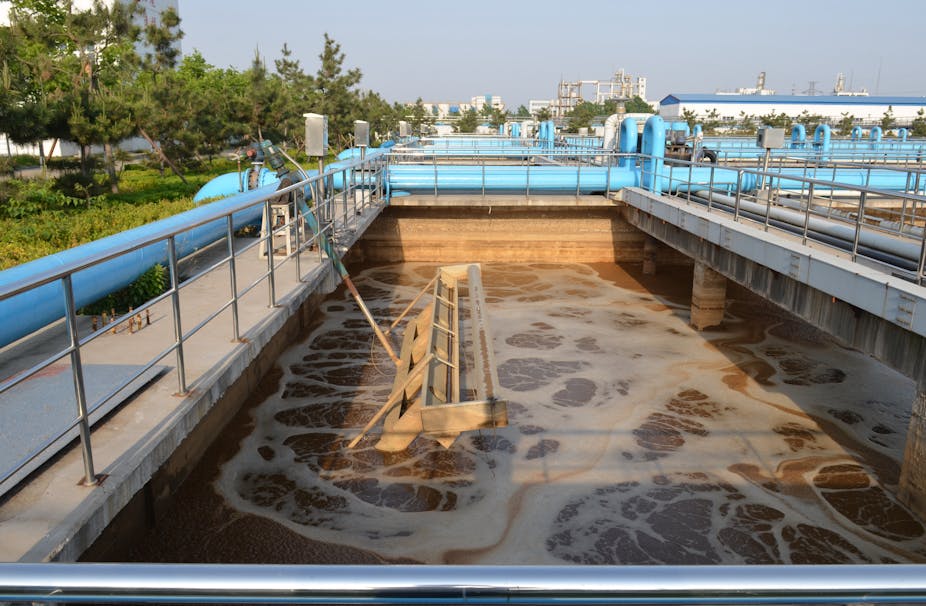The fight against antibiotic-resistant bacteria – so-called “superbugs” – is a huge challenge, one that the World Health Organization has described as a grave global problem.
When superbugs hit the headlines it’s often because of hospital outbreaks, such as the outbreak of Vancomycin Resistant Enterococcus that infected babies in Melbourne in 2013. Yet the problem isn’t confined to hospitals – the wider environment can be important in the development and spread of these bugs, and people can be infected through food and water.
The problem of antibiotic resistance is being exacerbated worldwide by the pollution of waste water with leftover drugs, providing breeding grounds for resistant bacteria and their genes. The problem can persist for years, constantly refreshed by new discharges of both drugs and of resistant bacteria themselves, shed by people and animals.

Warning from history
The fact that penicillin was found in soldiers’ urine in the second world war was, in hindsight, an early indication that antibiotics are present in waste water, and that drugs like this might go on to have an afterlife in streams, lakes and other waterways, clinging to sediment particles and upsetting the delicate bacterial balances in soils and aquatic ecosystems.
But no-one gave the issue much thought until chance intervened in 1992, when German scientists looking for herbicides in rivers, groundwater and lakes stumbled across a chemical they didn’t recognise – it turned out to be the cholesterol-lowering drug clofibrate, a cousin of the weedkiller 2-4-D.
No end of pharmaceutical pollution has since been found in the world’s water – analgesics, antibiotics, lipid regulators, antiseptics, beta-blockers, contraceptive hormones, anticonvulsants and X-ray contrast agents. Detectable levels of clofibrate alone are now found throughout the North Sea.
We now know that partially degraded drugs and ointments can be converted back into their active form through chemical reactions once you’ve said goodbye to them in the loo or shower. Many biodegrade, but others can be very persistent in their new environmental home.
Water treatment plants are thus the last barrier to drug residues and other synthetic chemicals being set loose into soils and waterways (meanwhile, there is no barrier at all for freely administered livestock drugs such as the antibiotics sulphasalazine and oxytetracycline).
Crucial treatment
Treatment plants’ ability to strip out waste drugs varies enormously according to age, level of expertise and design standard. Even the best ones don’t remove all foreign chemicals. Advanced treatment processes are designed more for removing pathogens than for breaking down molecules, although chlorination and what’s known in the trade as “ozonation” do have some ability to change the chemistry of drug molecules (to exactly what is unclear).
As the use of recycled water increases, the quality of this water becomes more critical and good management of all sewer inputs by water companies becomes more important. Thus, pharmaceuticals are being identified as a potential risk in recycled water risk-management systems of utilities such as South East Water in Melbourne, Orange County Sanitation District in California, and Singapore’s NEWater scheme.
This is leading to an increased awareness of the waste contributions from domestic catchments and high-concentration point sources such as hospitals.
It is time for the health and water industries to strike a bargain. Health professionals need to be aware of the need for pharmaceuticals to be managed as organic and persistent pollutants. They can help the water treatment industry by being aware of what their activities are putting into the sewerage and waste disposal systems, in view of the limited extent to which these systems can deal with the large number of drugs that are stable. They should consider prescribing less toxic, less environmentally persistent, but equally effective drugs where possible, as well as trying to reduce overall drug use in the community.
Meanwhile, Australia should build on its reputation for innovation in water management by addressing this health issue. Tackling hot spots in “source control” such as hospitals and clinics could make significant inroads on the amount of waste drugs entering treatment plants. Treatment at source may be preferable to facing increased trade waste charges by utilities if they deem hospital wastewater inputs to be problematic. Water firms should discourage hospital staff from emptying half-empty syringes into wash basins (which is probably common despite being against protocols). Rubbish disposal systems that minimise medicines ending up in landfill are another must.
The water industry should aim to ensure that treatment plants are operating under optimal conditions and that the older ones are either replaced or upgraded. Where appropriate, the industry could also help hospitals with in-house waste treatment, and suggest ways for householders to dispose of unwanted drugs – perhaps along the lines of Orange County’s No Drugs Down the Drain“ campaign.
The search for new antibiotics to beat superantibiotics goes on. The discovery of one of the very few new candidate antibiotics in the past 30 years, teixobactin, while encouraging, is no cause for complacency.
This article was co-authored by David Smith, water quality manager for South East Water, Melbourne.

